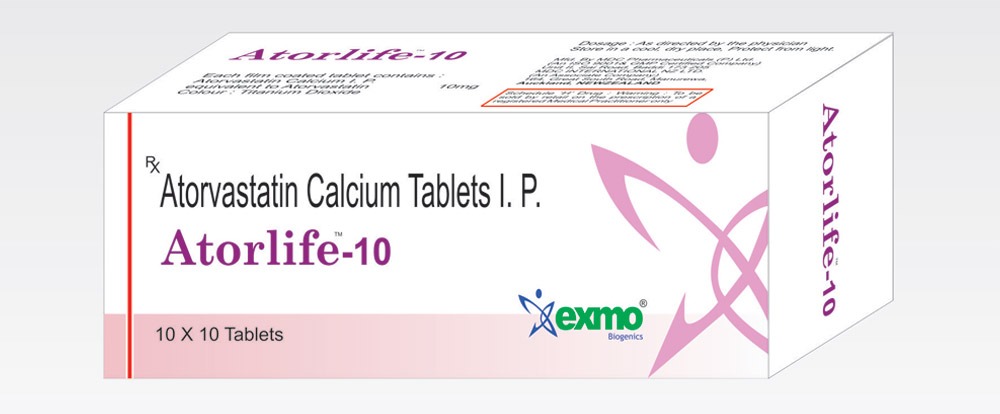

DESCRIPTION
Atorvastatin is a selective competitive inhibitor of 3-hydroxy-3-methyl-glutaryl- coenzyme A (HMG-CoA) reductase enzyme. This enzyme catalyzes the conversion of HMG-CoA to mevalonate, an early and rate-limiting step in the synthesis of cholesterol. In animal models, atorvastatin lowers plasma cholesterol and lipoprotein levels by inhibiting HMG-CoA reductase and cholesterol synthesis in the liver and by increasing the number of hepatic low density lipoprotein (LDL) receptors on the cell surface to enhance uptake and catabolism of LDL; atorvastatin also reduces LDL production and the number of LDL particles. Atorvastatin reduces LDL-cholesterol (LDL-C) in some patients with homozygous familial hypercholesterolemia, a population that rarely responds to other lipid- lowering medication(s). The primary site of action of HMG-CoA reductase inhibitors is the liver. Inhibition of cholesterol synthesis in the liver leads to upregulation of LDL-receptors and an increase in LDL- catabolism. There is also some reduction of LDL production as a result of inhibition of hepatic synthesis of very low density lipoprotein (VLDL), the precursor of LDL-C. Atorvastatin reduces total cholesterol, LDL-C and apo B in patients with homozygous and heterozygous familial hypercholesterolemia, non familial forms of hypercholesterolemia and mixed dyslipidemias. Atorvastatin also reduces VLDL-cholesterol (VLDL-C) and triglycerides and produces variable increases in high-density lipoprotein cholesterol (HDL-C) and apolipoprotein A1. Atorvastatin reduces total cholesterol, LDL-C, VLDL-C, apo B, triglycerides, and non-HDL-C, and increases HDL-C in patients with isolated hypertriglyceridemia. Atorvastatin also reduces intermediate density lipoprotein cholesterol (IDL-C) in patients with dysbetalipoproteinemia. Atorvastatin as well as some of its metabolites are pharmacologically active in humans. Drug dosage rather than systemic drug concentration correlates better.
INDICATIONS
PREVENTION OF CARDIOVASCULAR DISEASE
In adult patients without clinically evident coronary heart disease (CHD), but with multiple risk factors for CHD such as age, smoking, hypertension, low HDL-C, or a family history of early CHD,
ATORLIFE is indicated to:
Reduce the risk of myocardial infarction
Reduce the risk of stroke
Reduce the risk for revascularization procedures and angina
In patients with type 2 diabetes, and without clinically evident CHD, but with multiple risk factors for CHD such as retinopathy, albuminuria, smoking, or hypertension
ATORLIFE is indicated to:
Reduce the risk of myocardial infarction
Reduce the risk of stroke
In patients with clinically evident CHD,
ATORLIFE is indicated to:
Reduce the risk of non-fatal myocardial infarction
Reduce the risk of fatal and non-fatal stroke
Reduce the risk for revascularization procedures
Reduce the risk of hospitalization for CHF
Reduce the risk of angina
HYPERCHOLESTEROLEMIA
ATORLIFE is indicated:
As an adjunct to diet to reduce elevated total cholesterol, LDL-cholesterol, apo B and triglyceride levels and to increase HDL-C in patients with primary hypercholesterolaemia (heterozygous familial and nonfamilial) and mixed dyslipidaemia (Fredrickson Types IIa and lIb).
As adjunctive therapy to diet for the treatment of patients with elevated serum triglyceride levels (Fredrickson Type IV).
For the treatment of patients with primary dysbetalipoproteinaemia (FredricksonType III) who do not respond adequately to diet.
To reduce total cholesterol and LDL-C in patients with homozygous familial hypercholesterolaemia as an adjunct to other lipid lowering treatments (e.g. LDL apheresis) or if such treatments are unavailable.
As an adjunct to diet to reduce total cholesterol, LDL-C and apo B levels in boys and menarchal girls, 10 to 17 years of age, with heterozygous familial hypercholesterolaemia, if after an adequate trial of diet therapy, the following findings are present:
a. LDL-C remains > 190 mg/dl or
b. LDL-C remains > 160 mg/dl and
there is a positive family history of premature cardiovascular disease or two or more other CVD risk factors are present in the pediatric patient.
Lipid-altering agents should be used in addition to a diet restricted in saturated fat and cholesterolonly when the response to diet and other nonpharmacological measures has been inadequate [see National Cholesterol Education Program (NCEP) Guidelines, summarized in the table below].
CONTRAINDICATIONS
Hypersensitivity to any component of this medication Active liver disease or unexplained persistent elevations of serum transaminases exceeding three times the upper limit of normal Pregnancy and Lactation.